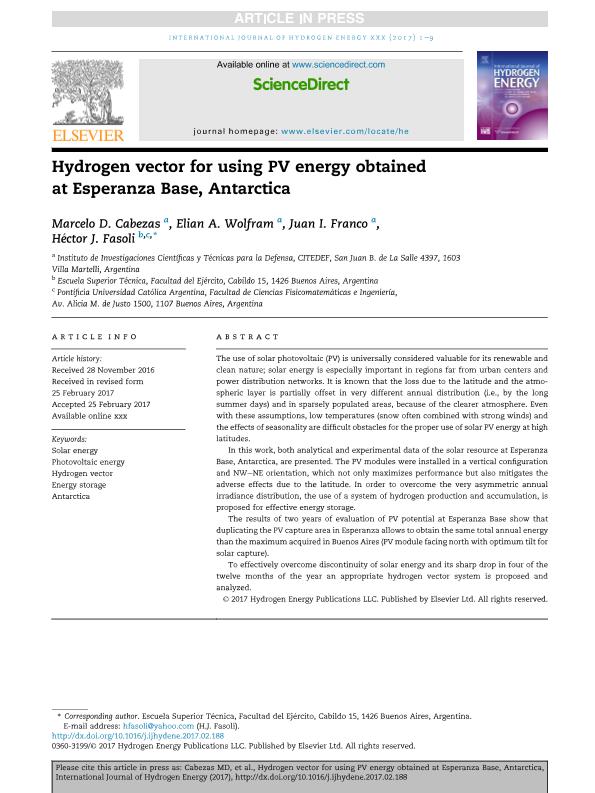Mostrar el registro sencillo del ítem
dc.contributor.author
Cabezas, Marcelo Daniel

dc.contributor.author
Wolfram, Elian Augusto

dc.contributor.author
Franco, Juan Isidro

dc.contributor.author
Fasoli, Hector J.
dc.date.available
2018-03-13T20:56:21Z
dc.date.issued
2017-03
dc.identifier.citation
Cabezas, Marcelo Daniel; Wolfram, Elian Augusto; Franco, Juan Isidro; Fasoli, Hector J.; Hydrogen vector for using PV energy obtained at Esperanza Base, Antarctica; Pergamon-Elsevier Science Ltd; International Journal of Hydrogen Energy; 42; 37; 3-2017; 23455-23463
dc.identifier.issn
0360-3199
dc.identifier.uri
http://hdl.handle.net/11336/38719
dc.description.abstract
The use of solar photovoltaic (PV) is universally considered valuable for its renewable and clean nature; solar energy is especially important in regions far from urban centers and power distribution networks. It is known that the loss due to the latitude and the atmospheric layer is partially offset in very different annual distribution (i.e., by the long summer days) and in sparsely populated areas, because of the clearer atmosphere. Even with these assumptions, low temperatures (snow often combined with strong winds) and the effects of seasonality are difficult obstacles for the proper use of solar PV energy at high latitudes. In this work, both analytical and experimental data of the solar resource at Esperanza Base, Antarctica, are presented. The PV modules were installed in a vertical configuration and NW–NE orientation, which not only maximizes performance but also mitigates the adverse effects due to the latitude. In order to overcome the very asymmetric annual irradiance distribution, the use of a system of hydrogen production and accumulation, is proposed for effective energy storage. The results of two years of evaluation of PV potential at Esperanza Base show that duplicating the PV capture area in Esperanza allows to obtain the same total annual energy than the maximum acquired in Buenos Aires (PV module facing north with optimum tilt for solar capture). To effectively overcome discontinuity of solar energy and its sharp drop in four of the twelve months of the year an appropriate hydrogen vector system is proposed and analyzed.
dc.format
application/pdf
dc.language.iso
eng
dc.publisher
Pergamon-Elsevier Science Ltd

dc.rights
info:eu-repo/semantics/openAccess
dc.rights.uri
https://creativecommons.org/licenses/by-nc-nd/2.5/ar/
dc.subject
Antarctica
dc.subject
Energy Storage
dc.subject
Hydrogen Vector
dc.subject
Photovoltaic Energy
dc.subject
Solar Energy
dc.subject.classification
Meteorología y Ciencias Atmosféricas

dc.subject.classification
Ciencias de la Tierra y relacionadas con el Medio Ambiente

dc.subject.classification
CIENCIAS NATURALES Y EXACTAS

dc.title
Hydrogen vector for using PV energy obtained at Esperanza Base, Antarctica
dc.type
info:eu-repo/semantics/article
dc.type
info:ar-repo/semantics/artículo
dc.type
info:eu-repo/semantics/publishedVersion
dc.date.updated
2018-03-12T19:28:48Z
dc.journal.volume
42
dc.journal.number
37
dc.journal.pagination
23455-23463
dc.journal.pais
Estados Unidos

dc.description.fil
Fil: Cabezas, Marcelo Daniel. Ministerio de Defensa. Instituto de Investigaciones Científicas y Técnicas para la Defensa; Argentina. Consejo Nacional de Investigaciones Científicas y Técnicas; Argentina
dc.description.fil
Fil: Wolfram, Elian Augusto. Ministerio de Defensa. Instituto de Investigaciones Científicas y Técnicas para la Defensa; Argentina. Consejo Nacional de Investigaciones Científicas y Técnicas; Argentina
dc.description.fil
Fil: Franco, Juan Isidro. Ministerio de Defensa. Instituto de Investigaciones Científicas y Técnicas para la Defensa; Argentina
dc.description.fil
Fil: Fasoli, Hector J.. Ministerio de Defensa. Ejército Argentino. Instituto de Enseñanza Superior del Ejército. Escuela Superior Técnica; Argentina. Pontificia Universidad Católica Argentina "Santa María de los Buenos Aires". Facultad de Ciencias Fisicomatemáticas e Ingeniería; Argentina
dc.journal.title
International Journal of Hydrogen Energy

dc.relation.alternativeid
info:eu-repo/semantics/altIdentifier/doi/http://dx.doi.org/10.1016/j.ijhydene.2017.02.188
dc.relation.alternativeid
info:eu-repo/semantics/altIdentifier/url/https://www.sciencedirect.com/science/article/pii/S036031991730770X
Archivos asociados
